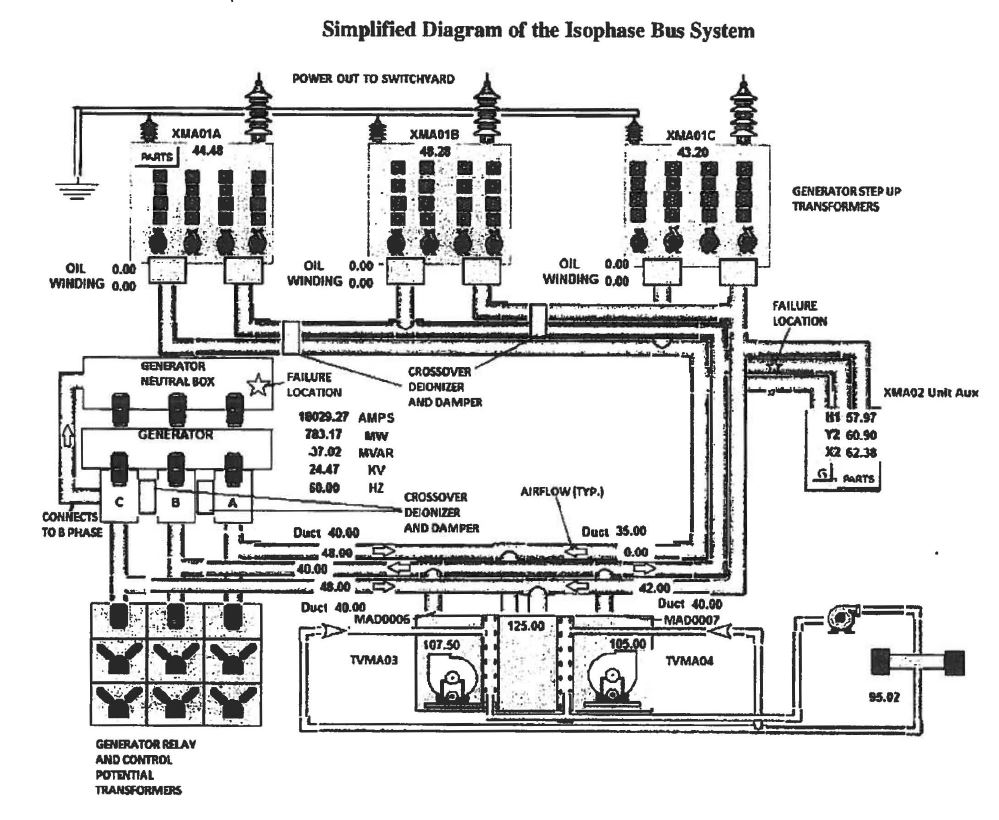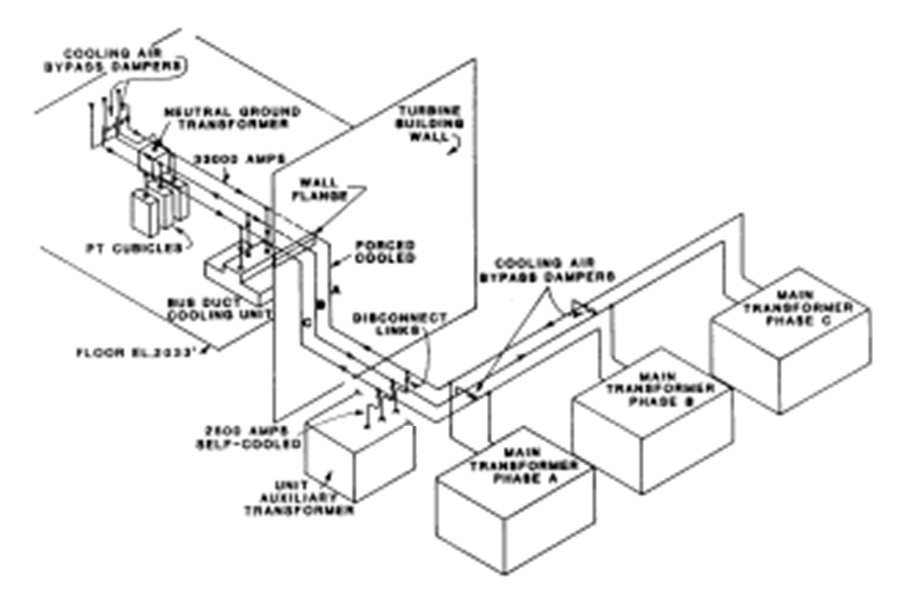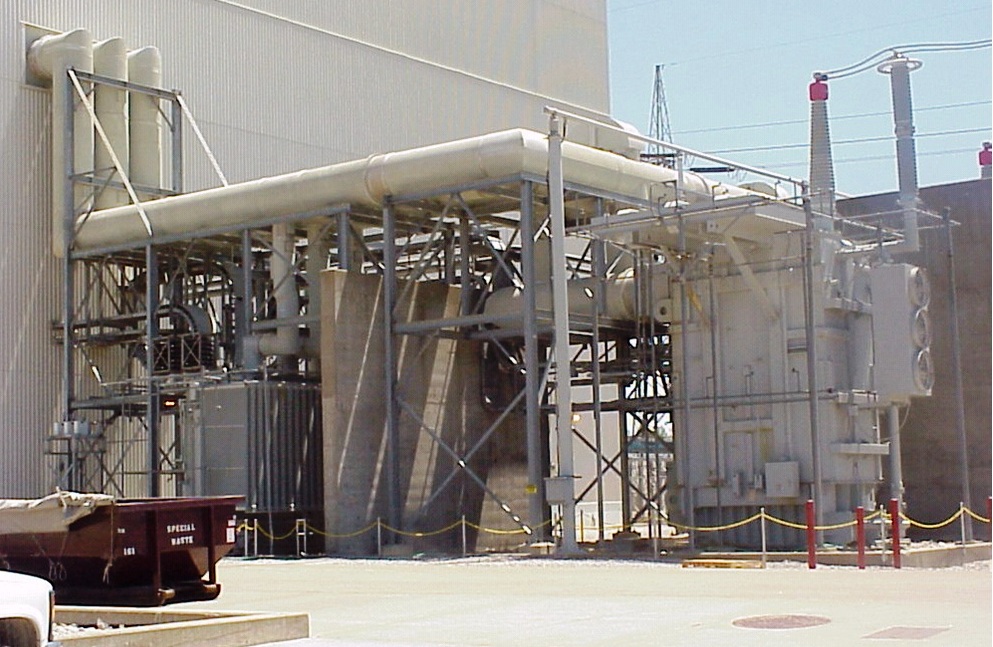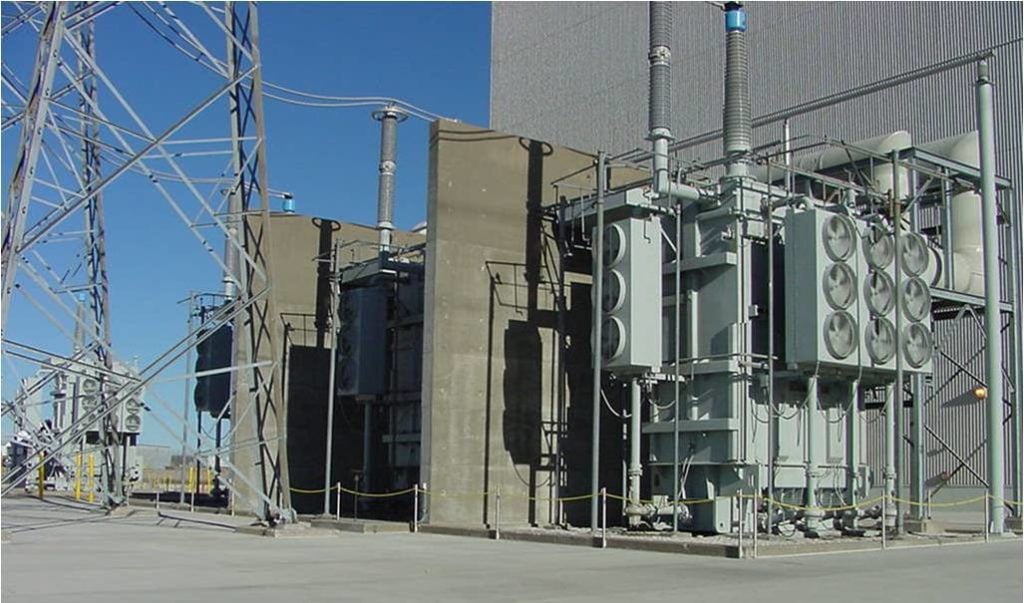Fission Stories #160
At 11:19 pm July 26, 2013, the Callaway nuclear plant in Missouri operated at 100 percent power when workers took isophase bus cooling fan TVMA04 out of service, replacing it with fan TVMA03. Workers swap these fans every month to equalize wear and tear on them.
Wait for it, wait for it—less than fifteen minutes later, the Callaway nuclear plant would be shut down and on fire.
After putting out the fire and dealing with some other problems triggered by the unplanned shut down (like a flooded basement in the turbine building), workers looked into the cause of the alarms, fire, and shut down. They found it was largely self-inflicted.
What Happened
The purpose of the Callaway nuclear plant is to generate electricity supplied to the power grid for transmission to residential and commercial customers. Heat produced by splitting atoms in the reactor core is used to boil water. The steam spins a turbine connected to a generator.
Callaway’s generator (shown in the left center of Fig.1) produces 25,000 volts of alternating current electricity. Alternating current electricity has three phases. Each phase is carried by individual metal plates termed an isophase (isolated phase) bus to its own transformer (upper left). The transformers increase the voltage from 25,000 volts to 345,000 volts and supply it to the transmission lines of the offsite power grid.
As electricity flows through the isophase buses, the metal heats up. Each isophase bus is encased within a large tube. A gap of several inches exists between the isophase bus and its tubular enclosure. The isophase bus cooling fans (lower center) blow air into the tube encasing the B isophase bus. The air flows through this tube and then through crossover deionizer and damper connections near the transformers to the tubes around the A and C isophases. Warmed air returns from the A and C isophase bus tubes to the cooling fan unit. Before being recycled by an isophase bus cooling fan, the air flows past water-filled tubes (shown by the two vertical rectangles with black notches between the two fans) to be cooled down.
Workers swapped cooling fans by closing the outlet damper (MAD0007) for fan TMVA04. The damper’s closure automatically started fan TVMA03. When Callaway was shut down for refueling in fall 2011, workers found that one of the blades in damper MAD0007 (these dampers are somewhat like floor grates in homes with blades that can be opened/closed to control air floor into a room) had broken. They noticed the broken blade, but they did not retrieve its missing pieces.
After the fans swapped, the changing air flow pattern within the tube surrounding the B isophase bus blew an aluminum piece or pieces of the broken damper onto the energized bus. This metal-to-metal contact caused electrical arcing (static electricity on a nuclear-scale) that vaporized the aluminum metal. Air carried ionized gas and vaporized metal particles through the B isophase bus duct. This dust and debris settled in two low-flow regions—at the generator neutral box (left center of Fig. 1) and on the B isophase bus going to Unit Auxiliary Transformer XMA02 (right center of Fig. 1). Fig. 2 shows the physical layout of the schematic in Fig. 1.
The three isophase bus ducts exit the turbine building to the upper left. In the middle of the Fig. 3, isophase buses branch off the main buses and go to the Unit Auxiliary Transformer on the right.
The three isophase bus ducts continued on to their individual transformers. The A main transformer is in the foreground of Fig. 4, the B main transformer in the middle, and the C main transformer peeks around the edge of a protective wall in the background. (The transformers are cooled by external fans, visible on the A main transformer, and internal oil systems. Electrical faults have caused rapid oxidation of this oil—“explosions” in non-nukespeak. The concrete walls direct forces upward and outward to protect adjacent transformers from the rapid oxidation domino effect.)
The electrical arcing caused an automatic shut down of the turbine/generator, which in turn caused an automatic shut down of the reactor as designed. Electrical arcing on the generator end ignited nearby flammable materials.
The Operator’s Response
Security officers quickly informed the control room operators about smoke. Some security personnel stationed in the turbine building (which housed the generator and now a fire) were repositioned to alternate locations. The plant’s fire brigade responded to the fire.
Sixteen minutes after the arcing and shut downs, the NRC’s Incident Response Center was notified that an emergency—an Unusual Event, the least serious of the NRC’s four emergency classifications—was being declared due to a fire lasting longer than 15 minutes.
Twenty-nine minutes after the arcing and shut downs, the fire brigade leader notified the control room operators that the fire had been extinguished.
An hour and twenty-three minutes after the arcing and shut downs, workers notified the control room of significant leakage from the system used to purify water flowing from the condenser to the steam generators that was flooding the basement of the turbine building. (The cause of this leak, its consequences, and corrective actions taken to fix it are not known because the owner’s written report to the NRC mentioned it in only 20 words. It is presumed that the basement was pumped out, or that sufficient inflatable boats were procured to enable workers to access equipment in the basement.)
Seven hours after the fire was out, the NRC’s Incident Response Center was again notified—this time to clarify that the emergency should not have been declared due to the fire but due to the smoke and toxic fumes it emitted that prevented workers from freely accessing portions of the turbine building.
The ensuing investigation revealed that the actual flow rate through the isophase bus ducts was nearly double the rated flow rate, increasing both the likelihood that the dampers would fail and the consequences of a damper failure. The high flow rate blew broken damper pieces into harm’s way. Workers replaced the dampers with ones designed to handle the higher system flow rates as well as downstream grating to catch damper bits.
In addition, the investigation revealed that design and installation errors at the generator neutral box made it vulnerable to electrical faults. Workers modified the generator neutral connection box before restarting the plant.
Our Takeaway
The design and installation errors at the main generator neutral connection box dated back to construction of the plant in the late 1970s and early 1980s. Their remaining undetected for the next three decades is unfortunate, but not unexpected. They were subtle in nature and the vulnerability they introduced was only evident when metal particles were present. It would have been a stellar catch to have identified these errors during past testing and inspections.
The emergency misclassification, in this case, made little difference. The emergency classification level remained the same and the only revision involved the reason for its declaration. The misclassification had zero effect on the nature of response by workers or the NRC.
The followup to the identification of the broken and missing blade from the damper in fall 2011 cannot be so readily explained and accepted. The pieces of metal were not found near the damper or in the isophase bus cooler fan, so they clearly were somewhere down the line towards the isophase bus. Rather than searching for and retrieving these metal pieces, workers left the problem as-is and restarted the reactor. The surprise isn’t that the metal pieces caused arcing—the surprise is that it took nearly 18 months for them to do so.
The owner’s report did not explicitly indicate whether the following measure was or was not taken, but it would be prudent to go back and review other cases where known deficiencies were accepted as-is rather than fully remedied to see if they were properly justified or set the stage for future “surprises” as in this case.
Source of graphics: Ameren Missouri
“Fission Stories” is a weekly feature by Dave Lochbaum. For more information on nuclear power safety, see the nuclear safety section of UCS’s website and our interactive map, the Nuclear Power Information Tracker.




